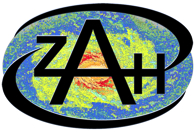My Research:
2. Galactic Globular Clusters
Preamble
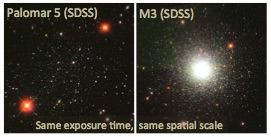 Star clusters cover a wide range of gravitationally bound stellar
agglomerates ranging from massive, compact, long-lived globular
clusters to low-mass, diffuse, short-lived associations, from
metal-poor objects to clusters with super-solar metallicity, and from
very old populations to embedded young clusters. It has been
suggested that all stars originally formed in clusters or asociations.
The study of the many types of clusters is worthwhile in its own right
and reveals important information on star formation processes and the
impact of galactic environment. A crucial advantage of star clusters
relative to field star populations is that they represent, to first
order, coeval populations and can be easily age-dated when they are
resolved into individual stars. Star clusters have been identified in
all galaxy types except for the least massive ones. As ensembles,
star clusters can serve as a very useful tracer of galaxian star
formation history.
Star clusters cover a wide range of gravitationally bound stellar
agglomerates ranging from massive, compact, long-lived globular
clusters to low-mass, diffuse, short-lived associations, from
metal-poor objects to clusters with super-solar metallicity, and from
very old populations to embedded young clusters. It has been
suggested that all stars originally formed in clusters or asociations.
The study of the many types of clusters is worthwhile in its own right
and reveals important information on star formation processes and the
impact of galactic environment. A crucial advantage of star clusters
relative to field star populations is that they represent, to first
order, coeval populations and can be easily age-dated when they are
resolved into individual stars. Star clusters have been identified in
all galaxy types except for the least massive ones. As ensembles,
star clusters can serve as a very useful tracer of galaxian star
formation history.
The work presented in this section was done with my past and present graduate students and postdocs Corrado Boeche, Maria Cordero, Matthias Frank, Daniel Harbeck, Katrin Jordi, Andrea Kayser, Andreas Koch, Sarah Martell, Michael Odenkirchen, Geneviève Parmentier, and Frederik Schönebeck.
Subtopics
- 2.1 Abundance Inhomogeneities and Multiple Stellar Populations
- 2.2 Dissolution of Globular Clusters
- 2.3 The Globular Cluster Contribution to Halo Field Stars
- 2.4 Testing Fundamental Physics with Globular Clusters
2.1 Abundance Inhomogeneities and Multiple Stellar Populations
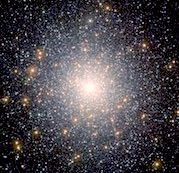 While globular clusters typically show a negligible star-to-star iron
abundance or metallicity spread, it has been known for decades that
they exhibit significant star-to-star light element abundance
variations in elements like Na, Al, Mg, C, N, O. Several scenarios
have been suggested to explain this puzzling fact, but its origin
remains unresolved. Stellar evolutionary effects such as rotational
mixing and dredge-up of CNO-processed material are among the possible
mechanisms. In his PhD thesis, my graduate student Daniel Harbeck
carried out the then deepest spectroscopic survey of main-sequence
stars in 47 Tucanae. We found that these unevolved stars show CN
bimodalities down to 0.65 solar masses, making an evolutionary origin
unlikely due to the low efficiency of CNO burning at those masses (Harbeck, Smith, & Grebel 2003a). Deriving C and N
abundances, we could show that the anticorrelations seen along the
main sequence agree very well with those on the red giant branch,
implying that the surface abundances remain almost unchanged across
this range of different masses and evolutionary states (Briley et al. 2004).
While globular clusters typically show a negligible star-to-star iron
abundance or metallicity spread, it has been known for decades that
they exhibit significant star-to-star light element abundance
variations in elements like Na, Al, Mg, C, N, O. Several scenarios
have been suggested to explain this puzzling fact, but its origin
remains unresolved. Stellar evolutionary effects such as rotational
mixing and dredge-up of CNO-processed material are among the possible
mechanisms. In his PhD thesis, my graduate student Daniel Harbeck
carried out the then deepest spectroscopic survey of main-sequence
stars in 47 Tucanae. We found that these unevolved stars show CN
bimodalities down to 0.65 solar masses, making an evolutionary origin
unlikely due to the low efficiency of CNO burning at those masses (Harbeck, Smith, & Grebel 2003a). Deriving C and N
abundances, we could show that the anticorrelations seen along the
main sequence agree very well with those on the red giant branch,
implying that the surface abundances remain almost unchanged across
this range of different masses and evolutionary states (Briley et al. 2004).
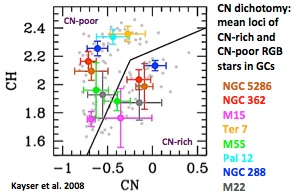 In our studies of additional globular clusters, we found CN and CH
anticorrelations on the red giant branch, the subgiant branch, and in
the main-sequence turn-off region (e.g., Harbeck, Smith, & Grebel 2003b, Kayser et al. 2008). For hotter stars, the CN
absorption tends to be weaker. While we did not see correlations
between light element abundance variations and the structural
parameters of the globular clusters, there may be a trend of more
CN-strong stars with increasing cluster tidal radius and total
luminosity (Kayser et al. 2008). In this study led by my
graduate student Andrea Kayser we also found that, intriguingly, the
two least luminous, least massive, most metal-rich and youngest
globular clusters in our sample, Terzan 7 and Palomar 12, do not show
any CN-strong stars (Kayser et al. 2008). These two globulars are
believed to belong to the Sagittarius dwarf spheroidal galaxy.
We also did not find conclusive evidence for light element abundance
variations in the distant, low-mass, low-metallicity outer halo
globular cluster Palomar 14 (Çalışkan, Christlieb, & Grebel
2012).
In our studies of additional globular clusters, we found CN and CH
anticorrelations on the red giant branch, the subgiant branch, and in
the main-sequence turn-off region (e.g., Harbeck, Smith, & Grebel 2003b, Kayser et al. 2008). For hotter stars, the CN
absorption tends to be weaker. While we did not see correlations
between light element abundance variations and the structural
parameters of the globular clusters, there may be a trend of more
CN-strong stars with increasing cluster tidal radius and total
luminosity (Kayser et al. 2008). In this study led by my
graduate student Andrea Kayser we also found that, intriguingly, the
two least luminous, least massive, most metal-rich and youngest
globular clusters in our sample, Terzan 7 and Palomar 12, do not show
any CN-strong stars (Kayser et al. 2008). These two globulars are
believed to belong to the Sagittarius dwarf spheroidal galaxy.
We also did not find conclusive evidence for light element abundance
variations in the distant, low-mass, low-metallicity outer halo
globular cluster Palomar 14 (Çalışkan, Christlieb, & Grebel
2012).
In recent years, photometric studies have revealed the presence of multiple stellar populations in the color-magnitude diagrams of globular clusters, which are often interpreted as a sign of at least two generations of star formation (see also Section 1.4) and which have also been linked to the occurrence of light element abundance dichotomies. Second-generation star formation scenarios suggest that clusters need to have a certain minimum mass for such star formation to occur - a possible explanation for the absence of the light element abundance variations in Ter 7 and Pal 12. In agreement with these expectations, so far no light element abundance anticorrelations have been detected in the much less massive open clusters; a result that is being further tested by graduate student Clio Bertelli, also with respect to chemical tagging. Postdoc Frederik Schönebeck, on the other hand, explores to what extent integrated spectra of Galactic globular clusters may reveal the presence of multiple populations and light element abundance variations.
2.2 Dissolution of Globular Clusters
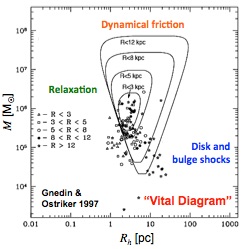 Globular clusters may get disrupted and ultimately dissolved by
various dynamical processes including internal relaxation processes,
dynamical friction, and disk and bulge shocks (e.g., Gnedin & Ostriker 1997). Their survival depends
on their intrinsic mass and density as well as on the gravitational
potential, their distance to a galaxy's center, and on their orbits.
Hence today we see the survivors of these processes; of globular
clusters that were once a much more numerous population. Destroyed
globular clusters contribute their stars to the field star population
of their host galaxy.
Globular clusters may get disrupted and ultimately dissolved by
various dynamical processes including internal relaxation processes,
dynamical friction, and disk and bulge shocks (e.g., Gnedin & Ostriker 1997). Their survival depends
on their intrinsic mass and density as well as on the gravitational
potential, their distance to a galaxy's center, and on their orbits.
Hence today we see the survivors of these processes; of globular
clusters that were once a much more numerous population. Destroyed
globular clusters contribute their stars to the field star population
of their host galaxy.
Can we see evidence of such processes? - Using wide-field imaging data from the Sloan Digital Sky Survey (SDSS) and a special color-magnitude filter technique, in a study led by my postdoc Michael Odenkirchen we discovered extended, massive tidal tails around the sparse globular cluster Palomar 5 (Odenkirchen et al. 2001). The narrow, well-defined tails show a number of knots (Odenkirchen et al. 2001, Rockosi et al. 2002), implying that they form a dynamically cold, long-lived structure (Odenkirchen et al. 2003). Our spectroscopic follow-up revealed that Palomar 5 itself as well as the stars in its tails have a very low line-of-sight velocity dispersion (Odenkirchen et al. 2002, 2009). We found the tails to contain more mass than the cluster in its present state and suggest that Palomar 5 will likely be destroyed after its next disk crossing in about 110 Myr (Odenkirchen et al. 2003, Dehnen et al. 2004). In a study led by my graduate student Andreas Koch we studied the luminosity and mass functions of Palomar 5 and found the cluster to have experienced significant mass segregation with the tails to be enhanced in low-mass stars. Even the binary star population shows mass segregation with the more massive binaries being more strongly concentrated toward the cluster center (Koch et al. 2004).
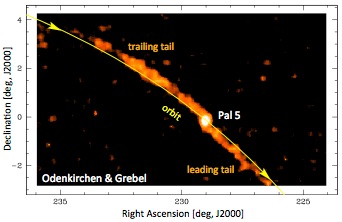 Although the "vital diagram" of Gnedin & Ostriker (1997) suggests that additional
globular clusters should be undergoing disruption at the present time,
very few additional globular clusters with evident tidal tails have
been found so far (e.g., NGC 5466; see Odenkirchen & Grebel 2004). Earlier studies on
photographic plates were often hampered by background galaxy clusters
that were indistinguishable from stars at the plates' resolution and
mistaken for tidal tails. A systematic study of 17 globular clusters
observed by the SDSS by my graduate student Katrin Jordi recovered the
known tidal tails around these two globular clusters and revealed
indications of tidal tails or extratidal features around a number of
others (Jordi & Grebel 2010). Several globular clusters
show pronounded extratial halos some of which may be associated with
the Sagittarius dwarf spheroidal galaxy (Jordi & Grebel 2010). We identified additional
extratidal stars around the globular clusters M22, NGC 1851, NGC 3201,
and ω Centauri based on chemical and kinematic tagging with RAVE
(Kunder et al. 2014; Anguiano et al. 2015, 2016). The candidates for NGC 3201 tidal debris
are found at angular distances of up to 80° on the sky (Anguiano et al. 2016).
Although the "vital diagram" of Gnedin & Ostriker (1997) suggests that additional
globular clusters should be undergoing disruption at the present time,
very few additional globular clusters with evident tidal tails have
been found so far (e.g., NGC 5466; see Odenkirchen & Grebel 2004). Earlier studies on
photographic plates were often hampered by background galaxy clusters
that were indistinguishable from stars at the plates' resolution and
mistaken for tidal tails. A systematic study of 17 globular clusters
observed by the SDSS by my graduate student Katrin Jordi recovered the
known tidal tails around these two globular clusters and revealed
indications of tidal tails or extratidal features around a number of
others (Jordi & Grebel 2010). Several globular clusters
show pronounded extratial halos some of which may be associated with
the Sagittarius dwarf spheroidal galaxy (Jordi & Grebel 2010). We identified additional
extratidal stars around the globular clusters M22, NGC 1851, NGC 3201,
and ω Centauri based on chemical and kinematic tagging with RAVE
(Kunder et al. 2014; Anguiano et al. 2015, 2016). The candidates for NGC 3201 tidal debris
are found at angular distances of up to 80° on the sky (Anguiano et al. 2016).
Interestingly, despite the disruption and evaporation of globular clusters, the cored radial mass density profile of the Galactic halo's globular cluster system including seems to be in good agreement with the distribution of the cold baryonic material of the protogalaxy and appear to be preserved in time (Parmentier & Grebel 2005).
2.3 The Globular Cluster Contribution to Halo Field Stars
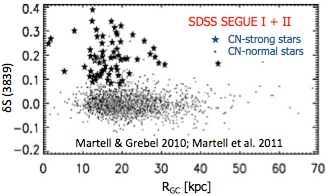 Present-day star formation teaches us that stars usually form in
clusters and associations, many of which will then disperse through
internal and external dynamical effects. As laid out above, the old
globular clusters observed today are believed to be the survivors of a
once much more numerous cluster population. The examples of Palomar 5
and NGC 5466 show that we can find observational evidence for
continuing globular cluster dissolution even today (e.g., Odenkirchen et al. 2001, Odenkirchen & Grebel 2004), and the discovery of
extended tidal debris of globular clusters provides further support
for this picture (e.g., Jordi & Grebel 2010; Kunder et al. 2014; Anguiano et al. 2015, 2016). This leads to the
intriguing question of how many of the present halo field stars
were formed in star clusters, particularly in since disrupted globular
clusters?
Present-day star formation teaches us that stars usually form in
clusters and associations, many of which will then disperse through
internal and external dynamical effects. As laid out above, the old
globular clusters observed today are believed to be the survivors of a
once much more numerous cluster population. The examples of Palomar 5
and NGC 5466 show that we can find observational evidence for
continuing globular cluster dissolution even today (e.g., Odenkirchen et al. 2001, Odenkirchen & Grebel 2004), and the discovery of
extended tidal debris of globular clusters provides further support
for this picture (e.g., Jordi & Grebel 2010; Kunder et al. 2014; Anguiano et al. 2015, 2016). This leads to the
intriguing question of how many of the present halo field stars
were formed in star clusters, particularly in since disrupted globular
clusters?
We are trying to address this question by exploiting the light element abundance variations in globular cluster stars since they do not seem to exist in field stars. In fact, they are believed to be a consequence of second-generation star formation in globular clusters. Thus, if a globular cluster gets disrupted it will contribute stars both with "normal" and with "anomalous" light element abundances to the surrounding field. In a study led by my postdoc Sarah Martell, we searched for chemical signatures of stellar debris from such events among halo field stars (Martell & Grebel 2010, Martell et al. 2011). Using spectra from the SDSS, we found about 2.5% of inner halo stars to be CN-strong, consistent with second-generation stars that originated in globulars. Depending on the chosen evolutionary scenario for multiple stellar populations in globular clusters, this may imply that at least 17% of the present-day stellar mass of the inner halo may have formed originally in globular clusters of sufficiently high mass to host stars with light element enhancements. Interestingly, there is a marked decline of CN-strong stars with Galactocentric distance, suggesting little contribution from dissolved globular clusters to the outer halo (Martell et al. 2011). My postdoc Maria Cordero is currently extending these studies using data from other surveys and soon also from Gaia.
There is a marked decline of CN-strong stars with Galactocentric distance, suggesting little contribution from dissolved globular clusters to the outer halo (Martell et al. 2011). It has been suggested that the stellar outer halo mainly consists of accreted low-mass dwarf galaxies. The abundance properties of outer halo globular clusters like Palomar 14 are compatible with an accretion origin from dwarf spheroidal galaxies (Çalışkan, Christlieb, & Grebel 2012).
2.4 Testing Fundamental Physics with Globular Clusters
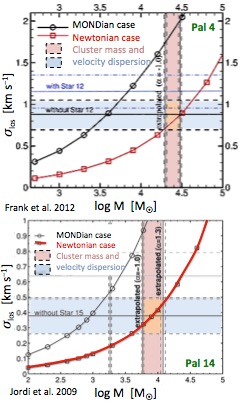 Modified Newtonian Dynamics (MOND; e.g., Milgrom 1983) is the perhaps best known theory of
the proposed alternatives to the widely accepted cold dark matter
model. Despite the successes of the cold dark matter scenario across
a wide range of cosmic objects and scales, there has been no direct
detection of dark matter thus far. The nature of this invisible
matter, which has been found to be the dominant matter component in
the Universe, remains a major puzzle. Hence it is worthwhile to also
consider alternatives such as other gravitational theories like MOND.
For more than 30 years, MOND has defied all attempts to disprove it
while having had considerable success explaining a range of different
observations.
Modified Newtonian Dynamics (MOND; e.g., Milgrom 1983) is the perhaps best known theory of
the proposed alternatives to the widely accepted cold dark matter
model. Despite the successes of the cold dark matter scenario across
a wide range of cosmic objects and scales, there has been no direct
detection of dark matter thus far. The nature of this invisible
matter, which has been found to be the dominant matter component in
the Universe, remains a major puzzle. Hence it is worthwhile to also
consider alternatives such as other gravitational theories like MOND.
For more than 30 years, MOND has defied all attempts to disprove it
while having had considerable success explaining a range of different
observations.
Globular clusters are an interesting target to further test MOND, since they are believed to be free of dark matter. We devised a method to test MOND via line-of-sight radial velocity measurements in globular clusters in the remote outer halo where MOND effects become prominent (Baumgardt, Grebel, & Kroupa 2005). If MOND is valid, the velocity dispersions of these globular clusters would exceed the ones expected from Newtonian gravity by up to a factor of three, providing a stringent test for MOND, whereas very high velocity dispersions would provide first evidence that globular clusters are dark matter dominated after all (Baumgardt, Grebel, & Kroupa 2005; Haghi et al. 2009).
Palomar 14, a remote halo globular cluster studied by my graduate student Katrin Jordi revealed a low velocity dispersion in agreement with the prediction for Newtonian gravity (Jordi et al. 2009). Also, the inferred cluster mass is higher than the theoretically predicted mass in the case of MOND. Moreover, there is no need to invoke the presence of dark matter in Pal 14 (Jordi et al. 2009). My graduate student Matthias Frank showed that this globular cluster shows pronounced mass segregation. One possible explanation is that the cluster formed already extended and with primordial mass segregation (Frank, Grebel, & Küpper 2014), which may provide additional support for the aforementioned accretion origin of Pal 14 (Çalışkan, Christlieb, & Grebel 2012).
Also the distant halo globular cluster Palomar 4 shows a significant depletion in low-mass stars in its center as compared to its outskirts as my graduate student Matthias Frank demonstrated (Frank et al. 2012). Since the relaxation time of Pal 4 is of the order of a Hubble time, this points to primordial mass segregation in this cluster. The cluster mass and measured velocity dispersion are consistent with the expectations of Newtonian dynamics and below the prediction for MOND (Frank et al. 2012). The excellent match between photometric and dynamical cluster mass and the low mass-to-light ratio of Pal 4 implies that there is no indication for dark matter in this cluster either.
References
- Anguiano, B., De Silva, G.M., Freeman, K., Da Costa, G.S., Zwitter, T., Quillen, A.C., Zucker, D.B., Navarro, J.F., Kunder, A., Siebert, A., Wyse, R.F.G., Grebel, E.K., et al. 2016, MNRAS, 457, 2078
- Anguiano, B., Zucker, D.B., Scholz, R.-D., Grebel, E.K., et al. 2015, MNRAS, 451, 1229
- Baumgardt, H., Grebel, E.K., & Kroupa, P. 2005, MNRASL, 359, L1
- Briley, M.M., Harbeck, D., Smith, G.H., & Grebel, E.K. 2004, AJ, 127, 1588
- Çalışkan, Ş., Christlieb, N., & Grebel, E.K. 2012, A&A, 537, 83
- Dehnen, W., Odenkirchen, M., Grebel, E.K., & Rix, H.W. 2004, AJ, 127, 2753
- Frank, M.J., Grebel, E.K., Küpper, A.H.W. 2014, MNRAS, 443, 815
- Frank, M.J., Hilker, M., Baumgardt, H., Côté, P., Grebel, E.K., Haghi, H., Küpper, A.H.W., & Djorgovski, S.G. 2012, MNRAS, 423, 2917
- Gnedin, O.Y., & Ostriker, J.P. 1997, ApJ, 474, 223
- Haghi, H., Baumgardt, H., Kroupa, P., Grebel, E.K., Hilker, M., & Jordi, K. 2009, MMRAS, 395, 1549
- Harbeck, D., Smith, G.H., & Grebel, E.K. 2003a, AJ, 125, 197
- Harbeck, D., Smith, G.H., & Grebel, E.K. 2003b, A&A, 409, 553
- Jordi, K., & Grebel, E.K. 2010, A&A, 522, 71
- Jordi, K., Grebel, E.K., Hilker, M., Baumgardt, H., Frank, M., Kroupa, P., Haghi, H., Côté, P., & Djorgovski, S.G. 2009, AJ, 137, 4586
- Kayser, A., Hilker, M., Grebel, E.K., & Willemsen, P.G. 2008, A&A, 486, 437
- Koch, A., Grebel, E.K., Odenkirchen, M., Martínez-Delgado, D., & Caldwell, J.A.R. 2004, AJ, 128, 2274
- Kunder, A., Bono, G., Piffl, T., Steinmetz, M., Grebel, E.K., et al. 2014, A&A, 672, A30
- Martell, S.L., & Grebel, E.K., 2010, A&A, 519, 14
- Martell, S.L., Smolinski, J.P., Beers, T.C., & Grebel, E.K. 2011, A&A, 534, 136
- Milgrom, M. 1983, ApJ, 270, 365
- Odenkirchen, M., Grebel, E.K., Rockosi, C.M., et al. 2001, ApJ Letters, 548, L165
- Odenkirchen, M., Grebel, E.K., Dehnen, W., Rix, H.-W., & Cudworth, K.M. 2002, AJ, 124, 1497
- Odenkirchen, M., Grebel, E.K., Dehnen, W., et al. 2003, AJ, 126, 2385
- Odenkirchen, M., & Grebel, E.K. 2004, in Satellites and Tidal Streams, ASP Conf. Ser. 327, eds. F. Prada, D. Martínez-Delgado, & T.J. Mahoney (ASP: San Francisco), p. 284
- Odenkirchen, M., Grebel, E.K., Kayser, A., Rix, H.-W., & Dehnen, W. 2009, AJ, 137, 3378
- Parmentier, G., & Grebel E.K. 2005, MNRAS, 359, 615
- Rockosi, C.M., Odenkirchen, M., Grebel, E.K., et al. 2002, AJ, 125, 349
Back to research overview
